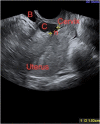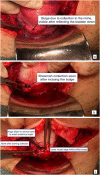Post-caesarean Niche (Isthmocele) in Uterine Scar: An Update
- PMID: 33417629
- PMCID: PMC7758379
- DOI: 10.1007/s13224-020-01370-0
Post-caesarean Niche (Isthmocele) in Uterine Scar: An Update
Abstract
Uterine niche is one of the emerging complications of caesarean section. With rising caesarean rates, the caesarean-related iatrogenic complications are also on the rise. These include placenta accreta, scar ectopic pregnancy and uterine niche which is a newer entity being described in the recent literature. Uterine niche, also described as uterine isthmocele, caesarean scar defect and diverticulum, is an iatrogenic defect in the myometrium at the site of previous caesarean scar due to defective tissue healing. Patients may have varied symptoms including abnormal uterine bleeding, post-menstrual spotting and infertility, though many women may be asymptomatic and diagnosed incidentally. Diagnosis is made radiologically by transvaginal sonography, saline instillation sonohysterography or magnetic resonance imaging. Occurrence of niche may be prevented by using correct surgical technique during caesarean. Patients may be managed medically; however, subfertility and persistent symptoms may require surgical correction either by hysteroscopic resection or transabdominal or transvaginal repair. This mini-review comprehensively covers the potential risk factors, clinical presentation, diagnosis and management of this increasingly encountered condition due to rising caesarean rates.
Keywords: Caesarean scar defect; Isthmocele; Uterine niche.
© Federation of Obstetric & Gynecological Societies of India 2020.
Conflict of interest statement
Conflict of interestNone of the authors have any potential conflict of interest.
Figures


Similar articles
-
Hysteroscopic and laparoscopic management of caesarean scar (niche) defects in symptomatic patients.J Obstet Gynaecol. 2018 Jul;38(5):730. doi: 10.1080/01443615.2018.1444394. J Obstet Gynaecol. 2018. PMID: 29944046
-
A large post-caesarean Niche (Isthmocele) with amenorrhea, a symptom that was not reported in the medical literature: A rare case report.Int J Surg Case Rep. 2023 Aug;109:108528. doi: 10.1016/j.ijscr.2023.108528. Epub 2023 Jul 24. Int J Surg Case Rep. 2023. PMID: 37499350 Free PMC article.
-
Determination of Isthmocele Using a Foley Catheter During Laparoscopic Repair of Cesarean Scar Defect.J Minim Invasive Gynecol. 2018 Jan;25(1):21-22. doi: 10.1016/j.jmig.2017.05.017. Epub 2017 Jun 8. J Minim Invasive Gynecol. 2018. PMID: 28602788
-
Isthmocele: an overview of diagnosis and treatment.Rev Assoc Med Bras (1992). 2019 Jun 3;65(5):714-721. doi: 10.1590/1806-9282.65.5.714. Rev Assoc Med Bras (1992). 2019. PMID: 31166450 Review.
-
Cesarean scar defects: an underrecognized cause of abnormal uterine bleeding and other gynecologic complications.J Minim Invasive Gynecol. 2013 Sep-Oct;20(5):562-72. doi: 10.1016/j.jmig.2013.03.008. Epub 2013 May 14. J Minim Invasive Gynecol. 2013. PMID: 23680518 Review.
Cited by
-
Isthmocele diagnosis: The optimal timing for detection.Int J Gynaecol Obstet. 2025 Feb;168(2):844-846. doi: 10.1002/ijgo.15892. Epub 2024 Sep 3. Int J Gynaecol Obstet. 2025. PMID: 39224957 Free PMC article.
-
Prevalence and Clinical Features of Uterine Isthmocele Following Cesarean Sections: An Observational Study at Rabia Balkhi Hospital in Afghanistan.Cureus. 2024 Nov 27;16(11):e74610. doi: 10.7759/cureus.74610. eCollection 2024 Nov. Cureus. 2024. PMID: 39735064 Free PMC article.
-
Diagnostic yield of transvaginal ultrasonography versus saline: infused sonohysterography in the evaluation of post-cesarean section uterine niche.J Ultrasound. 2025 Mar;28(1):107-117. doi: 10.1007/s40477-024-00969-7. Epub 2024 Nov 18. J Ultrasound. 2025. PMID: 39556186
-
Intrauterine Adhesion-Induced Septated Amniotic Cavity: Ultrasonographic Findings in Second and Third Trimesters.Diagnostics (Basel). 2024 Dec 16;14(24):2826. doi: 10.3390/diagnostics14242826. Diagnostics (Basel). 2024. PMID: 39767187 Free PMC article.
-
Association of caesarean scar defect with risk of abnormal uterine bleeding: results from meta-analysis.BMC Womens Health. 2024 Jul 29;24(1):432. doi: 10.1186/s12905-024-03198-6. BMC Womens Health. 2024. PMID: 39075427 Free PMC article.
References
-
- Naji O, Abdallah Y, Bij De Vaate AJ, Smith A, Pexsters A, Stalder C, McIndoe A, Ghaem-Maghami S, Lees C, Brolmann HA, Huirne JA, Timmerman D, Bourne T. Standardized approach for imaging and measuring Cesarean section scars using ultrasonography. Ultrasound Obstet Gynecol. 2012;39:252–259. doi: 10.1002/uog.10077. - DOI - PubMed
-
- van der Voet LF, Bij de Vaate AM, Veersema S, Brölmann HA, Huirne JA. Long-term complications of caesarean section. The niche in the scar: a prospective cohort study on niche prevalence and its relation to abnormal uterine bleeding. BJOG. 2014;121(2):236–244. doi: 10.1111/1471-0528.12542. - DOI - PubMed
Publication types
LinkOut - more resources
Full Text Sources
Medical
